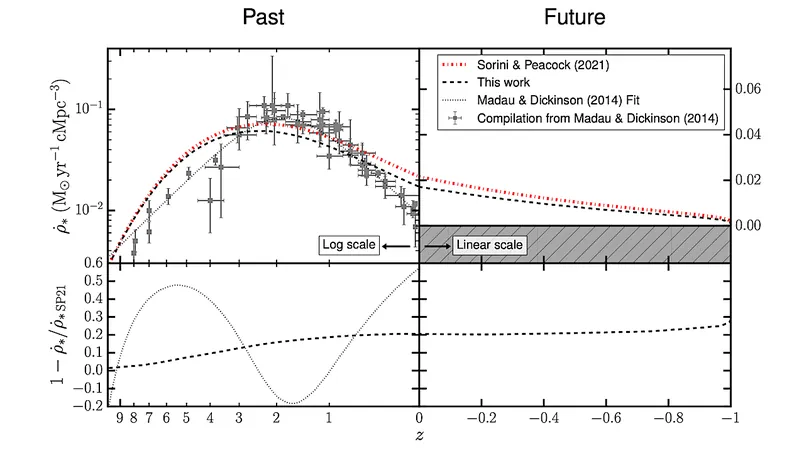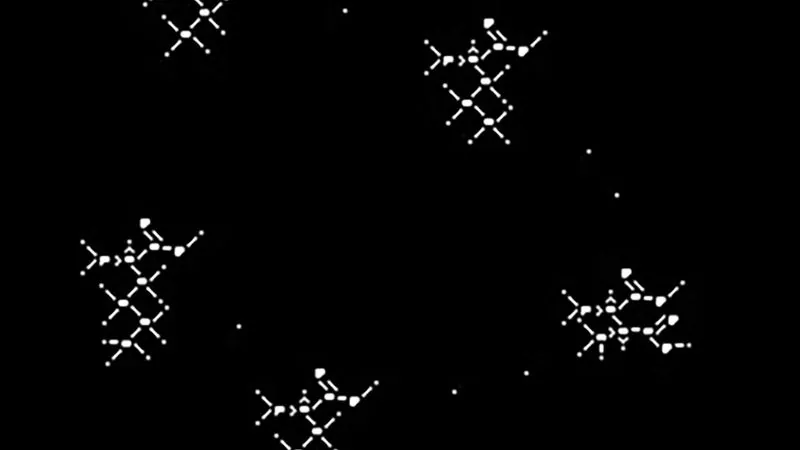
Cosmic Unveiling: How the Cosmological Constant Shapes Stellar Birth and Death
2024-11-23
Author: Noah
Overview
In a groundbreaking study, researchers have developed a comprehensive analytical model to explore cosmic star formation within the ΛCDM (Lambda Cold Dark Matter) framework. This model aims to shed light on how varying cosmological parameters, particularly the cosmological constant (Λ), influence the star formation history of the universe.
Flat ΛCDM Models
The team constructed a diverse set of flat ΛCDM models, in which they varied the cosmological constant between Λ=0 and up to 105 times the currently observed value, Λ_obs. Their findings reveal a fascinating peak in star formation efficiency, with approximately 27% of cosmic baryons—essentially the building blocks of stars—converted into stars when the cosmological constant is within a specific range, notably between 0.01 and 1 times Λ_obs.
Understanding Efficiency Peaks
But what causes this efficiency peak? The researchers elaborated that at lower values of Λ, factors related to star formation's astrophysical processes limit efficiency. Conversely, at higher absolute values of Λ, the formation of cosmic structures becomes suppressed, hindering stellar formation. Notably, the decline in star formation efficiency occurs gradually with increasing values of Λ, only dropping below 5% when Λ exceeds 100 times Λ_obs.
Proportion of Observers
Continuing on, the researchers adopted a minimal assumption: that the likelihood of the universe generating observers is directly proportional to this star-forming efficiency. In line with the work of physicist Steven Weinberg, a flat prior on Λ was established, leading to a median posterior value of approximately 539 times Λ_obs. Additionally, the probability of observing values of Λ at or below Λ_obs stands shockingly low at just 0.5%.
Implications and Questions
This scenario raises intriguing questions about the perceived fine-tuning of the universe and the anthropic principle, which suggests that the universe appears crafted for life because many different universes exist with varying properties. The researchers argue that either this reasoning is flawed or that there are more variables at play in the cosmic ensemble than just the cosmological constant itself.
Conclusion
This pivotal research not only enhances our understanding of cosmic evolution and stellar genesis but also poses profound implications for theories of multiverse and anthropic reasoning, suggesting that our universe's properties might be much more surprising than we previously thought. The implications of these findings could reshape our understanding of cosmic dynamics and the fundamental principles governing the formation of stars across the vast universe.
Stay Tuned
Stay tuned as the cosmic saga continues to unfold, unraveling the mysteries of our universe one discovery at a time!









 Brasil (PT)
Brasil (PT)
 Canada (EN)
Canada (EN)
 Chile (ES)
Chile (ES)
 España (ES)
España (ES)
 France (FR)
France (FR)
 Hong Kong (EN)
Hong Kong (EN)
 Italia (IT)
Italia (IT)
 日本 (JA)
日本 (JA)
 Magyarország (HU)
Magyarország (HU)
 Norge (NO)
Norge (NO)
 Polska (PL)
Polska (PL)
 Schweiz (DE)
Schweiz (DE)
 Singapore (EN)
Singapore (EN)
 Sverige (SV)
Sverige (SV)
 Suomi (FI)
Suomi (FI)
 Türkiye (TR)
Türkiye (TR)